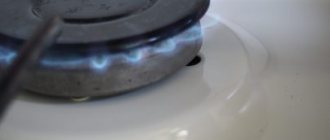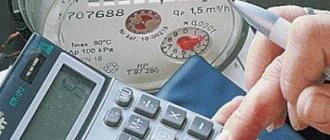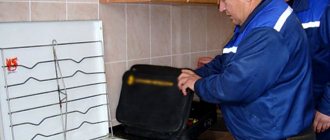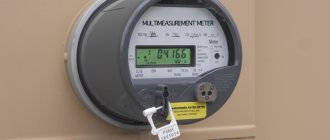Before connecting electricity to a private home yourself, you should determine the total power of the facility. To do this, you need to add up the power of all the expected electrical appliances that will function in the house (for example, refrigerators, microwave ovens, washing machines, computers, etc.), and increase the resulting figure by another quarter.
Before conducting electricity, based on calculations of the total power, you need to select one of two types of connection to the electrical network - single-phase (220) and three-phase (380). For an ordinary one-story house with a small total consumer power of up to 4-5 kW, a single-phase network is suitable. If the house will operate energy-intensive equipment - heating boilers, compressors, etc., then it is better to make a three-phase connection.
What do you need to connect electricity in your home?
To install electricity in a private home, you need to conclude an agreement with the distribution network (the company serving the network should have a sample), based on the application you wrote. It must indicate data about the object: location, purpose of connection, required power and other parameters. You should also provide:
- a document confirming ownership of the object;
- situational plan indicating the location of the electrical installation and the proposed connection point;
- design of a metering unit with calculation of the rating of the input circuit breaker and the current of the PZR installation;
- plan for connecting the power cable from the support to the metering station;
- grounding project;
- calculation of the power characteristics of the transformer, the capacity of the distribution cabinet and the network (for a three-phase network, you can ask the service company for an example).
Drawing up plans and design work is a licensed type of activity that requires the participation of specialists, and it will not be possible to prepare documents on your own. You can contact your regional distribution center and ask specialists to do all the calculations. Based on the received documents, the company will develop a connection project and issue a list of technical requirements for the facility.
The specified requirements for the facility must be met within two years from the date of drawing up the connection plan. Installation of an electric meter in a private residential building on the street is carried out after supplying electricity to the private house, followed by sealing. The service company will issue an invoice for installation, which will include a detailed connection diagram, the cost of the meter and other measuring instruments (if any), and will also provide certificates of work performed.
Next, a contract for the supply of electricity is concluded. All activities are carried out only by employees of the service company. It is prohibited to independently connect the site to electricity, and if detected, the offense is punishable by a serious fine.
Features of connecting electricity to a private home
The installation of an electricity meter in a private home has become a controversial issue between service organizations and subscribers over the past few years. The stumbling block is the requirement to install metering devices not inside, but outside of residential premises. RES motivates this by the fact that this way controllers get direct access to the meter to take readings, as well as carry out repair and maintenance work, and monitor the functioning of the meter.
Read also: Reconstruction and redevelopment of non-residential premises: approval and legalization by regulatory authorities
But at the same time, this requirement contains a contradiction that can be resolved by referring to the PUE - the rules for the construction of electrical installations. They clearly regulate the rules for installing an electric meter in a private house. The main points that need to be taken into account when installing a measuring and metering device in the house are:
- the connected device must be accessible for maintenance and inspection;
- the meter must be protected from atmospheric moisture;
- the air temperature during operation of the electrical appliance in winter should not be below zero;
- the device should be installed on a vertical surface at a height of 0.8 to 1.4 meters.
Installing an electric meter in a private house on support poles and other external structures without additional protective boxes is a violation of the PUE. Exposure to moisture, dust, and low temperatures lead to incorrect operation of the electrical appliance and incorrect readings of electricity consumption.
Another problem with outdoor installation of an electric meter in the private sector is accessibility and vulnerability to third parties: vandals or unscrupulous neighbors who can easily connect to a dedicated power grid. Of course, there are also special anti-vandal meters, but their cost is several times higher than that of a standard Mercury or other model for residential buildings. Representatives of the energy supply company do not have the right to demand that residents install expensive meter models, thereby solving their problems at the expense of the subscriber. To conduct electricity, you will be offered several options for devices:
- single tariff electricity meter;
- multi-tariff meter;
- multi-tariff meter with the ability to take readings remotely.
It is rational to install a multi-tariff meter if in the future you are going to use two tariffs (for example, day and night). If you will use electricity mainly during the daytime, then a single-tariff electrical appliance will be sufficient.
But experts still recommend opting for a multi-tariff metering device, since in the future it is possible to change the tariff, during which it will be necessary to replace the electricity meter in a private house. You will have to pay for it out of your own pocket, so even if you are going to use only one tariff for now, a multi-tariff meter will not hurt. The difference in cost between it and a conventional device is only 10-15%.
Installation of an electricity meter in a private house
To connect the meter correctly, you must follow the instructions.
Work order
Placing an IPU in a home requires certain skills. It is important to accurately calculate the planned power, which depends on the availability of electrical equipment. Based on this value, the type of device is determined: single- or three-phase.
Stages of approval and installation:
- An application for the need to connect a building to the power grid is submitted to the appropriate organization. The required power is indicated, supported by calculations, and the model and type of electric meter must be included. The authorized person issues a standard contract and provides the technical conditions necessary for connection. Coordination of individual details may be necessary.
- An individual project is drawn up. For these purposes, a specialist from a sales company or a certified company is involved.
- After clarifying all the nuances and obtaining permission, you can install the box and place an individual meter.
- To seal the electricity meter, if installation work is carried out independently or by a third party, you need to call an energy network employee. He will check the connection and, if everything is correct, will seal it and draw up a corresponding report. From this moment the electric meter is considered to be put into operation.
In the absence of experience and skills, it is recommended to involve specialists.
Taking the device outside
At the moment, due to the requirements of Energosbyt to install the meter not inside the premises, but outside, some disagreements are arising. Various location options are available: façade, pillar or specially erected structure.
Representatives of the company refer to Decree of the Government of the Russian Federation of May 4, 2012 No. 442. Indeed, the law states that IPUs must be installed along the border of the balance sheet ownership of the company’s energy networks and the site of the owner of the facility. This territory means the facade of a building or a boundary pillar, so many owners of private houses are required to take the device outside.
But if the owner does not want to change the location of the electricity meter, the owner can appeal to the PEU, which states that the mechanism must be located in a dry room with a temperature not lower than 0 °C. In addition, the consumer is directly responsible for the safety of the IPU, according to the Civil Code of the Russian Federation and RF PP No. 354. Thus, if the owner provides convenient, unobstructed access to the electric meter, there is no need to reinstall it.
You should know! Since the existing requirements contradict each other, if it is impossible to reach a compromise, the owner must contact the regulatory authority, prosecutor's office or court.
What is the best way to connect an electricity meter?
The best option for installing electricity meters is in a dry, warm place: the dressing room of a private house, in a summer kitchen or garden house, protected from precipitation and low temperatures. But such a connection method justifies itself in cases where the consumer does not prevent regulatory authorities from taking meter readings and performing other actions provided for by official authority.
If access to the residential premises is difficult for energy sales employees, then it is better to install the device on the facade of the house so that inspectors have access to it to take readings. If such an installation increases the risk of damage to the electrical appliance due to the actions of vandals and third parties, then you can request a standard balance sheet division agreement from the service company.
This will allow the boundaries of financial responsibility to be distributed between the electricity supplier and the consumer. If the requirement is to install it outside rather than inside the home, the company will be responsible for damage to the appliance, while the consumer will pay for the initial installation and cost of the meter.
Read also: Documents for registration of benefits for major repairs for pensioners after 70 years of age
If, to connect electricity, you decide to install a meter on the facade of the building, then in order to comply with the rules of the Electrical Installation Code, you must equip the electrical device with additional means of protection from atmospheric and temperature influences:
- external boxing with anti-vandal properties;
- internal box for installing electrical appliances and connecting electricity to a private home;
- special fastenings that prevent illegal dismantling, including using brute force and mechanical force (for example, sawing off with a grinder).

In this way, you will find a compromise between the requirements of the service organization for the outdoor installation of an electricity meter and your own financial interests. Installing protective boxes and anti-vandal mounts is a more affordable option compared to semi-industrial devices, the maintenance of which can cost up to 50 thousand rubles per month. Installing protective boxes for a conventional meter will cost much less - at the level of 4-5 thousand rubles.
Planned replacement of electricity meters in the private sector
If there is a need to change the electric meter as part of the planned mass replacement of outdated metering devices with new models, then a dispute about the location of installation of the new one may also arise between the subscriber and the service company. In this case, you may demand that the meter be installed indoors in a house, summer kitchen or garden house, explaining that the distribution network employees will have unhindered access to the electrical appliance.
If the company does not agree to make such a compromise, then an agreement should also be entered into with a division of the book value. If a meter installed on the street is stolen or damaged, the service company will pay for its replacement.
Replacement of electricity metering devices can be planned or unscheduled. In the second case, the need to change the meter arises when it is not working correctly or when there is visible damage to the seal and other components of the device. In this case, the cost of the meter and the work of specialists will have to be paid by the electricity consumer.
A planned replacement of electrical metering devices is also being carried out. Due to the growing number of energy-intensive consumers in the operation of residential buildings, old meter models are being replaced with new ones designed for high loads of up to 50 Amperes. Sometimes it is necessary to replace an already installed 2.5 accuracy class meter with devices with an increased accuracy class of 2.0 or 1.0. The procedure for replacing an electric meter, both scheduled and unscheduled, also involves the consumer contacting a service company with subsequent registration of all actions.
- A personal application is submitted to replace the electric meter in a private home.
- If it is possible to independently purchase a RES meter, a certificate is issued about the parameters of the required electrical appliance.
- If the meter is purchased directly from the service company, then a device passport is issued with it, which indicates the main characteristics for metering.
The passport must be kept; notes will be made in it during scheduled checks of metering devices by regulatory services. If disputes arise regarding the connection method and operating conditions of the meter, the subscriber has the right to refer to the Electrical Installation Rules, as well as take the necessary measures to protect the device from the effects of negative factors.
Rules for installing an electricity meter
- Installation of an electric meter in a private house should ensure that it is impossible to connect the consumer to the place of its installation. That is, to cut off the possibility of theft of electric current. And it doesn’t matter whether the device is being transferred or replaced with a new one.
- Installation of an electric meter in a private house must be carried out in a special panel or cabinet, into which other electrical devices can also be installed.
- The approach to the electrical panel must be free and convenient, and the panel itself must be installed smoothly without distortions.
- Mounting height – 0.8-1.7 m. Mounting below 0.8 m is allowed, but not below 0.4 m.
- Before installation, you must make sure that the next check in the state standard has not expired. To do this, you need to check the date of the last inspection or the date of manufacture of the device. For single-phase electricity meters the period is one year, for three-phase meters it is two years.
As an addition to these rules, there is one wish. The release to the meter should be installed no further than 10 m. This is in case you have to remove the metering and control device and check it. In this case, the release will simply de-energize the private house. However, it should be noted that the release, like the electric meter itself, will have to be installed in a sealed panel, which is sealed and locked. There is only one goal - to ensure the impossibility of unauthorized connection.










